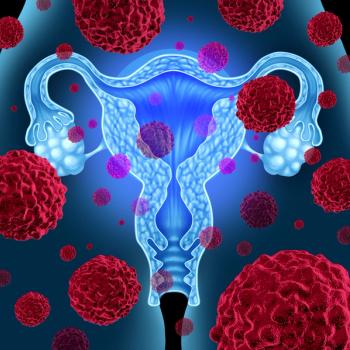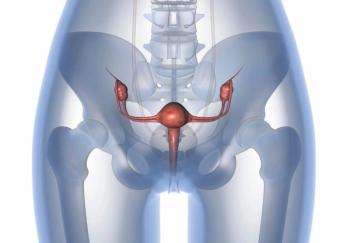
Oncology NEWS International
- Oncology NEWS International Vol 5 No 4
- Volume 5
- Issue 4
IP Cisplatin Delivery Appears to Improve Ovarian Ca Outcome
NEW ORLEANS--Intraperitoneal (IP) administration of cisplatin (Platinol) plus IV cyclophosphamide produced an improved outcome over IV cisplatin plus IV cyclophosphamide in a pivotal phase III ovarian cancer trial, intergroup study 0051 (SWOG-GOG-ECOG), researchers reported at the Society of Gynecologic Oncologists meeting.
NEW ORLEANS--Intraperitoneal (IP) administration of cisplatin(Platinol) plus IV cyclophosphamide produced an improved outcomeover IV cisplatin plus IV cyclophosphamide in a pivotal phaseIII ovarian cancer trial, intergroup study 0051 (SWOG-GOG-ECOG),researchers reported at the Society of Gynecologic Oncologistsmeeting.
Patients receiving cisplatin by the IP route vs IV administrationhad better survival and less clinical hearing loss, neuropathy,and neutropenia, said
David S. Alberts, MD, deputy director, Arizona Cancer Center,Tucson. "I believe this is a major advance in gynecologiconcology in terms of treating optimal disease ovarian cancer,"he said.
Eligible patients included 544 women with residual tumor of 2cm or less after primary surgery and no more than 4 weeks beforetherapy. They were randomized into the IP or IV arm (100 mg/m²cisplatin plus IV cyclophosphamide 600 mg/m²) to be givenin six courses at 3-week intervals. Patient characteristics werevery similar between the groups. Second-look laparotomies weredone at the conclusion of treatment.
Median survival (with more than 55 months of follow-up) was 49months in the IP arm and 41 months in the IV arm (P = .02). TheIP arm showed more pathological complete responses and less grossresidual disease, Dr. Alberts said.
The IV-to-IP death hazard ratio was 0.76, which suggested a 24%reduction in mortality for patients receiving regional drug administration.
"This is not a clinically insignificant finding," Dr.Alberts commented. "It is comparable to the effect of adjuvantCMF or tamoxifen in women with early-stage breast cancer. If Iwere showing a 24% reduction in mortality from breast cancer simplyby changing the dosing route of a standard drug treatment, peoplewould be standing up and applauding."
Patients with less than 0.5 cm residual disease at onset, however,showed a nonsignificant 20% reduction in mortality with the IProute. "This suggests, perhaps, that we should look at theaccuracy of small-volume residual disease quan-titation,"he added.
Given IP, the drug was better tolerated. Patients receiving IPcisplatin had 67% less clinical hearing loss (5% of patients vs15% of patients with IV administration), 47% less neuromusculartoxicity (10% vs 19%), and a 19% reduction in grade 3/4 neutropenia.
As expected, however, the IP group had more abdominal pain (18%well controlled vs 2% for IV) and more pulmonary toxicity (3%vs 0.4%). Overall performance status after treatment was similarfor the two groups, with 90% or more judged "excellent."
Study 'Reopens Questions'
The discussant for the presentation, James T. Thigpen, MD, professorof medicine, University Medical Center, Jackson, Miss, said thatthe study "reopens questions about IP therapy and promptsfurther study for confirmation before it becomes clinical practice."
He pointed out that the study failed to meet its stated objectiveof finding a hazard ratio of 0.67. He questioned the survivaladvantage of a 0.76 hazard ratio and the absence of benefit inpatients expected to profit most by IP, those with less than 0.5cm disease.
While acknowledging that some advantages were shown, IP deliveryalso produced more pain and pulmonary toxicity, he noted, andthe only two treatment related deaths occurred in this arm.
Dr. Alberts answered that to pinpoint a hazard ratio of 0.67 wouldhave required 2,000 patients. With regard to treatment deaths,the two in the IP arm occurred "early in the learning curve,"he replied. The IP route was clearly superior, he said: "Allyou have to do is ask women if a 67% decrease in severe clinicalhearing loss and a 24% decrease in mortality reduction are important."
Articles in this issue
over 29 years ago
Antiangiogenesis Agents in Clinical Trials Worldwideover 29 years ago
Breast Cancer Stamp Debuts in Juneover 29 years ago
NCI, Department of Defense Sign Clinical Trials Agreementover 29 years ago
NCI to Fund More Extramural Investigationsover 29 years ago
Lymphoma, Leukemia Patients Sought for Trial of MoAbover 29 years ago
'Integrated Symposia' New Feature at ASCO Conferenceover 29 years ago
Obstacles That Slow Guidelines ImplementationNewsletter
Stay up to date on recent advances in the multidisciplinary approach to cancer.





















































































